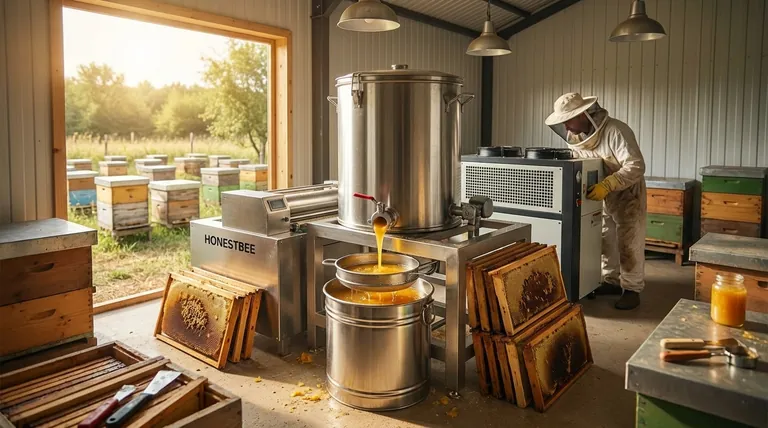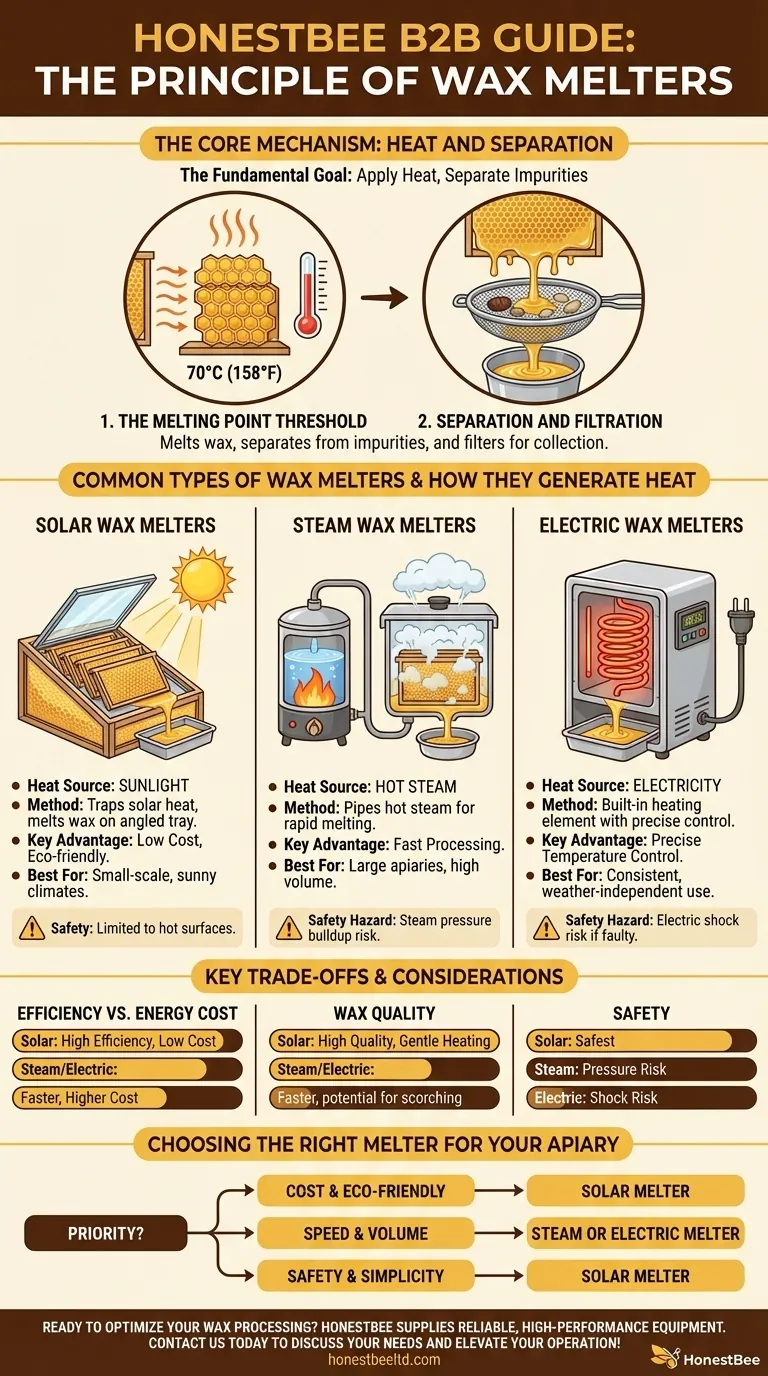At its core, a wax melter operates on a simple principle: it applies heat to honeycomb or raw beeswax, raising its temperature above the melting point of approximately 70°C (158°F). Once liquefied, the wax separates from impurities and can be collected, filtered, and processed for future use.
The fundamental goal is always to apply heat, but the method used to generate that heat—be it solar energy, steam, or electricity—is what differentiates the types of melters and dictates their efficiency, cost, and safety profile.

The Core Mechanism: Heat and Separation
The process of rendering beeswax from old honeycomb involves two simple physical stages, regardless of the equipment used.
The Melting Point Threshold
Every wax melter is designed to heat the material inside its main tank or chamber. The primary target is to consistently exceed the wax's melting point, which turns the solid comb into a liquid.
Separation and Filtration
As the wax melts, it flows away from the non-wax components of the comb (like cocoons and debris). Most melters incorporate a design where the liquid wax drains away, often through a sieve or mesh, to a separate collection pan or bucket for initial filtering.
Common Types of Wax Melters
While the principle is universal, the method of generating heat varies significantly between models. Each approach offers a distinct set of advantages and disadvantages.
Solar Wax Melters
A solar melter is an insulated box with a glass or transparent top, designed to trap heat from the sun's rays. Frames or loose comb are placed inside on an angled tray or mesh.
As the interior heats up, the wax melts and drips down the angled surface into a collection container. This method is environmentally friendly and requires no electricity or fuel.
Steam Wax Melters
These devices use hot steam as the heat transfer medium. A separate unit boils water to generate steam, which is then piped through a hose into a sealed container holding the wax frames.
The direct contact with hot steam rapidly melts the wax. This method is significantly faster than solar melting, making it suitable for processing larger quantities.
Electric Wax Melters
An electric melter functions much like other heating appliances, using a built-in electric heating element to raise the temperature inside the unit.
This offers precise temperature control and consistent performance independent of weather conditions, but it relies on a power source and carries the operational costs of electricity.
Key Trade-offs and Safety Considerations
Choosing a wax melter involves balancing speed, cost, and safety. Understanding the inherent risks of each design is critical for safe operation.
Efficiency vs. Energy Cost
Solar melters are the most energy-efficient, using free solar power, but they are also the slowest and entirely dependent on sunny weather. Steam and electric models are much faster but require fuel or electricity, adding an operational cost.
Wax Quality
Solar melters are often prized for producing very high-quality, clean, and light-colored beeswax. The slower, gentler heating process helps prevent scorching and discoloration.
Critical Safety Hazards
All wax melters operate at high temperatures, creating a burn risk. However, specific types have unique dangers:
- Steam Melters: Excessive heating can cause a dangerous buildup of steam pressure, potentially rupturing the container or hoses.
- Electric Melters: A faulty heating element or improper wiring poses a significant risk of electric shock.
- Solar Melters: These are considered the safest, as their primary hazard is limited to hot surfaces.
Choosing the Right Melter for Your Apiary
Your choice should align directly with the scale of your operation, your climate, and your priorities.
- If your primary focus is cost-effectiveness and environmental impact: A solar wax melter is the ideal choice for small-scale beekeepers in sunny climates.
- If your primary focus is processing speed and volume: A steam or electric wax melter will provide the power and efficiency needed for larger apiaries.
- If your primary focus is safety and simplicity: The solar wax melter is the most straightforward and presents the fewest operational risks.
Ultimately, selecting the right wax melter empowers you to efficiently reclaim one of the most valuable products from your hive.
Summary Table:
| Melter Type | Heat Source | Key Advantage | Best For |
|---|---|---|---|
| Solar | Sunlight | Low cost, eco-friendly | Small-scale, sunny climates |
| Steam | Hot steam | Fast processing | Large apiaries |
| Electric | Electricity | Precise temperature control | Consistent, weather-independent use |
Ready to optimize your wax processing? Whether you're a commercial apiary or a beekeeping equipment distributor, HONESTBEE supplies the reliable, high-performance wax melters and beekeeping equipment you need. Our wholesale-focused operations ensure you get the best value for your investment. Contact us today to discuss your needs and elevate your operation!
Visual Guide

Related Products
- Fully Automatic Beeswax Embossing Machine Foundation Mill
- Beeswax Machine Press Embosser Wax Foundation Mold Printer Bee Hive Equipment Making Sheet
- HONESTBEE Advanced Ergonomic Stainless Steel Hive Tool for Beekeeping
- Silicone Rubber Honey Drum Heating Belt
- Electric 8 Frame Honey Spinner Extractor Equipment for Beekeeping
People Also Ask
- What are the internal components of a solar waxer? Unlock Simple, Pure Wax Production
- Why is a wax melter beneficial for candle production? Achieve Faster, Safer, and More Consistent Results
- What should be done if wax cools and causes a blockage in the valve of the wax melter? Clear It Safely & Prevent It
- What is a wax melter used for in candle making? Achieve Professional, Scalable Production
- What is the best way to dissolve beeswax? Choose the Right Method for Cleaning or Crafting



















